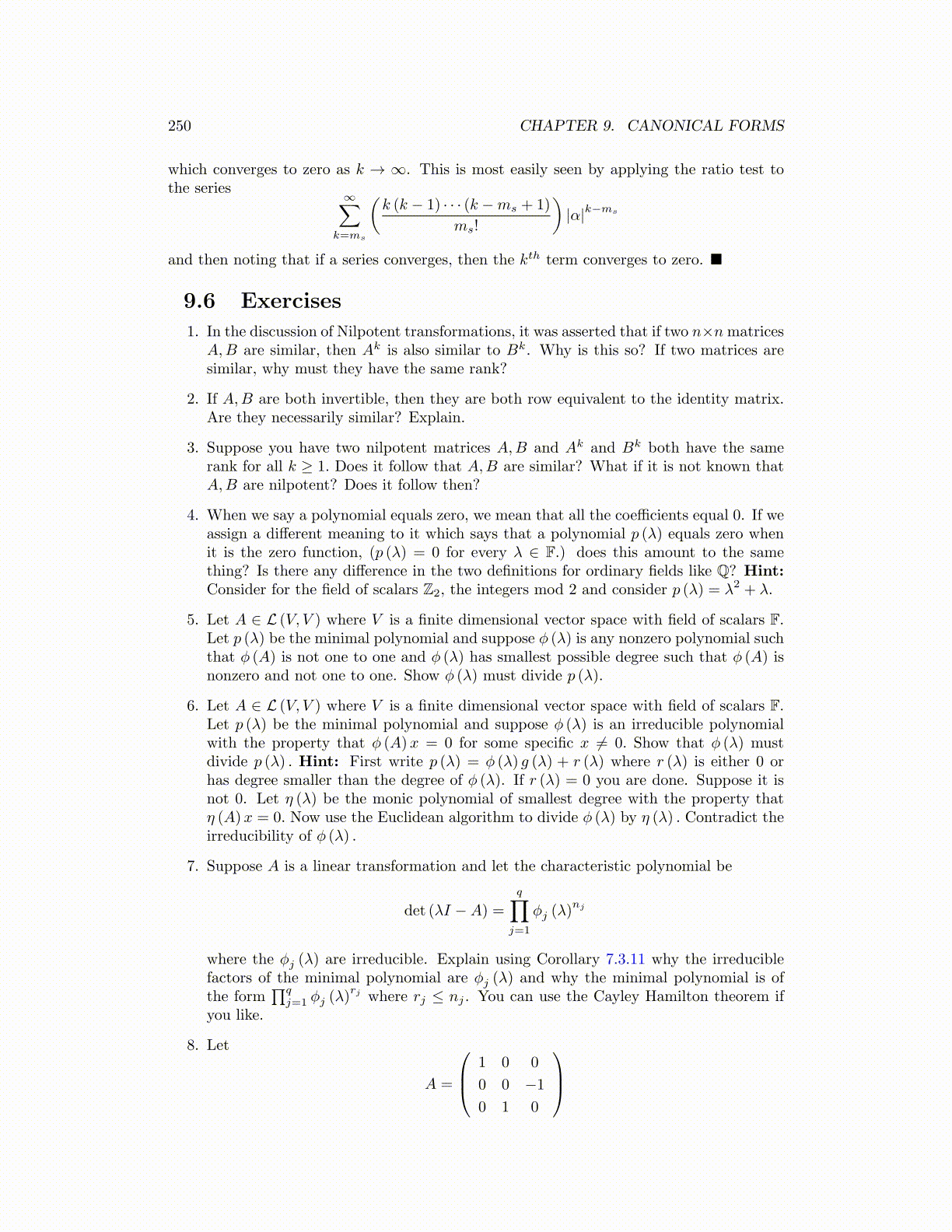
250 CHAPTER 9. CANONICAL FORMS
which converges to zero as k → ∞. This is most easily seen by applying the ratio test tothe series
∞∑k=ms
(k (k − 1) · · · (k −ms + 1)
ms!
)|α|k−ms
and then noting that if a series converges, then the kth term converges to zero. ■
9.6 Exercises
1. In the discussion of Nilpotent transformations, it was asserted that if two n×nmatricesA,B are similar, then Ak is also similar to Bk. Why is this so? If two matrices aresimilar, why must they have the same rank?
2. If A,B are both invertible, then they are both row equivalent to the identity matrix.Are they necessarily similar? Explain.
3. Suppose you have two nilpotent matrices A,B and Ak and Bk both have the samerank for all k ≥ 1. Does it follow that A,B are similar? What if it is not known thatA,B are nilpotent? Does it follow then?
4. When we say a polynomial equals zero, we mean that all the coefficients equal 0. If weassign a different meaning to it which says that a polynomial p (λ) equals zero whenit is the zero function, (p (λ) = 0 for every λ ∈ F.) does this amount to the samething? Is there any difference in the two definitions for ordinary fields like Q? Hint:Consider for the field of scalars Z2, the integers mod 2 and consider p (λ) = λ2 + λ.
5. Let A ∈ L (V, V ) where V is a finite dimensional vector space with field of scalars F.Let p (λ) be the minimal polynomial and suppose ϕ (λ) is any nonzero polynomial suchthat ϕ (A) is not one to one and ϕ (λ) has smallest possible degree such that ϕ (A) isnonzero and not one to one. Show ϕ (λ) must divide p (λ).
6. Let A ∈ L (V, V ) where V is a finite dimensional vector space with field of scalars F.Let p (λ) be the minimal polynomial and suppose ϕ (λ) is an irreducible polynomialwith the property that ϕ (A)x = 0 for some specific x ̸= 0. Show that ϕ (λ) mustdivide p (λ) . Hint: First write p (λ) = ϕ (λ) g (λ) + r (λ) where r (λ) is either 0 orhas degree smaller than the degree of ϕ (λ). If r (λ) = 0 you are done. Suppose it isnot 0. Let η (λ) be the monic polynomial of smallest degree with the property thatη (A)x = 0. Now use the Euclidean algorithm to divide ϕ (λ) by η (λ) . Contradict theirreducibility of ϕ (λ) .
7. Suppose A is a linear transformation and let the characteristic polynomial be
det (λI −A) =
q∏j=1
ϕj (λ)nj
where the ϕj (λ) are irreducible. Explain using Corollary 7.3.11 why the irreduciblefactors of the minimal polynomial are ϕj (λ) and why the minimal polynomial is ofthe form
∏qj=1 ϕj (λ)
rj where rj ≤ nj . You can use the Cayley Hamilton theorem ifyou like.
8. Let
A =
1 0 0
0 0 −1
0 1 0